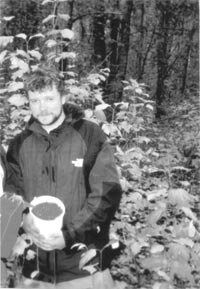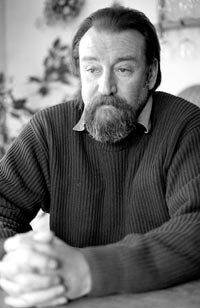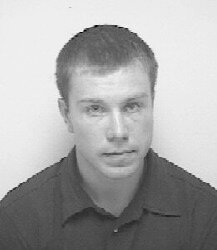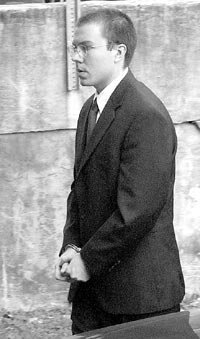No malice: Alston juror cites drunkenness
Since November, when former UVA student Andrew Alston was sentenced to three years in jail for stabbing 22-year-old firefighter Walker Sisk 18 times, many in Charlottesville have wondered what that jury was thinking.
Now they know.
In the 3,000-word cover story of the June edition of the Swarthmore College Bulletin, "Seek Justice, Love Mercy," juror Liz Kutchai describes how the jury rendered its verdict– and how emotionally devastating the experience was, not only for the families of the two young men, but for the jurors as well.
The prosecution had asked for conviction on a charge of second-degree murder, which carries a sentence of up to 40 years. The jury settled on voluntary manslaughter.
"The difference between the two was malice," writes Kutchai. "There was the legal definition of malice, and then there was our own everyday definition."
Her story suggests that drinking was key. The binge drinking that began November 7, 2003, and ended early the next morning stunned Kutchai, even though she has lived beside UVA for 30 years.
Trial testimony indicated that Sisk and his friends had visited five bars; Alston and his group had been "shot-gunning" beers at his apartment and then gone on to two different bars for beers and shots.
"What is Jaegermeister?" Kutchai asked the other jurors.
And, they wondered, "Could someone falling-down drunk have malice?" Kutchai recounts.
Apparently not. The jury ruled out that notion– and thus the possibility of a second-degree murder conviction.
"How can you not find malice when you stab someone that many times?" questions Howard Sisk, Walker's father. And it was Alston's brother, Kenny, who was falling down drunk, not Andrew Alston, who initially acted as peacemaker in the encounter between the two groups, according to testimony. "That sort of goes against the grain of the evidence in court," says Sisk.
Another factor in not finding malice, according to jury foreman Juandiego Wade, who works for the Albemarle County planning department: that when Alston "woke up that morning, it wasn't his intention" to stab Sisk to death.
The jurors considered whether the stabbing was in self-defense, which would have resulted in Alston's acquittal.
"Some of us were horrified by the 18 stab wounds," says Kutchai, a Quaker. "I couldn't imagine any situation that would call for pulling out a knife."
Kutchai didn't mention whether the jury's view would have changed had it known about Alston's first local act of alleged violence.
Two months before Sisk's death, Alston's girlfriend at the time, another UVA student, filed charges alleging he had struck her in the face. In a statement hurriedly written by Alston's father, a lawyer, who arrived in Charlottesville just hours after the alleged attack, Karen Graham recanted her story. At the assault trial, held two weeks after Alston killed Sisk, Charlottesville General District Judge Robert Downer cited reasonable doubt and acquitted Alston.
Kutchai says some of the jurors could see themselves in the diminutive Alston's shoes, imagining how, if a "very large, very drunk belligerent-sounding guy" was coming toward them, "it might take 18 stabs to subdue him," writes Kutchai.
However, the defense's martial arts argument, she says, didn't resonate as persuasively. Alston had studied aikido in the summer of 2002, and at the trial, his instructor demonstrated how, if Walker Sisk had grabbed Alston's knife, Alston might have pulled off defensive moves that would have resulted in Sisk stabbing himself 18 times. "No one believed the aikido ballet," writes Kutchai.
The jury was given 16 pages of complicated "legalese" before they began deliberating. The requirements for a determination of self-defense were even more obtuse than the definition of malice, and the jury had to parse every sentence, according to Kutchai.
"It's clear they struggled with the jury instructions," says Jon Zug, the assistant commonwealth's attorney who prosecuted the case.
He was not surprised by any of Kutchai's revelations from the jury room, and he knew going into court that the altercation between Sisk and Alston's friend, Bill Fahey, who was often described during the trial as "the mouthy one," would make the prosecution's case more difficult, because Alston was not initially involved in the verbal sparring.
Once the jury found Alston guilty of voluntary manslaughter, they still had to sentence him, and their only instruction was, "Pick a number from 1 to 10," says Kutchai in her account.
Everyone on the jury put a number on a piece of paper. "None of them came back with three years," says foreman Wade.
The jurors were "all over the map" with the sentence, says Kutchai, and had such a difficult time that they resorted to brainstorming about reasons for incarceration. "Justice made the list; vengeance did not," she writes. "Few of us were happy with the number we finally agreed on: three years."
Accompanying Kutchai's story is a photograph of her clutching a copy of the Hook, which ran a cover story on reactions to the trial. Kutchai wrote that this reporter quoted her as being "profoundly sad" while failing to mention that everyone on the jury was "committed to seeking justice."
Kutchai relays her own grief in the trial's aftermath, and relates how one sleepless night, she decided that if she could tell the Hook of her sadness, she could tell Walker Sisk's grieving parents. She describes writing them a letter and how when she ran into Sisk's father a month later, he thanked her for writing. "This was the beginning of my healing," she says.
Howard Sisk says Kutchai's letter helped him and his wife immensely. "I appreciated her taking the time to do that," he says. "She was one of the jurors not happy with the decision." And, he adds that Kutchai attended the sentencing, which only one other juror did.
Six months after the trial, Kutchai muses over the nature of healing, and she believes that for true healing to occur, Alston needs to atone for his behavior and accept that "If he had not pulled out his knife, the victim would not have bled to death on the sidewalk."
Again, Kutchai turns her focus to alcohol. Given the amount consumed that night, she suggests that Sisk might have died even if Alston hadn't stabbed him. "Both young men," she explains, "were very drunk and were heading back to their vehicles to drive home."
"That's sort of projecting there," responds Howard Sisk.
And Kutchai quotes the judge as despairing at the formal sentencing, "When will this binge drinking stop?"
Alston is incarcerated at Botetourt Correctional Center, which is a therapeutic community with programs for substance abuse.
Kutchai sees only one positive in this tragedy. "Incarceration may give the defendant the chance to gain control of his drinking and his anger," she concludes. "It may just save his life."
In a phone interview during her vacation in Wisconsin, Kutchai says writing the article was therapeutic for her, but she would not have written it for publication in Charlottesville. And she declines to elaborate on what went on in the jury room.
"I can't talk about the jury's decision," she says. "It was 12 people. Every person was committed to being objective, but we look at things with different filters."

Alston juror Liz Kutchai, Swarthmore College class of '66, tells alumni about participating in one of Charlottesville's most "heartbreaking" murder trials and calls it "one of the hardest things I have ever done."
FROM THE SWARTHMORE WEBSITE

Walker Sisk had planned to return to Alaska, where he spent the summer of 2003, and make firefighting his profession.
PHOTO COURTESY OF THE SISK FAMILY

"Obviously, they didn't think our son's life was worth that much," says Howard Sisk after the trial when the jury sentenced the man who killed Walker Sisk to a three-years.
PHOTO BY JEN FARIELLO

To critics, the three-year sentence seemed to confirm the idea that UVA students can get away with... manslaughter.

Former UVA biology student Andrew Alston, convicted of killing Walker Sisk, will be out of jail in less than a year– even without the appeal his attorney plans to file.
WILLIAM BARRATT/COURTESY THE CAVALIER DAILY
#
